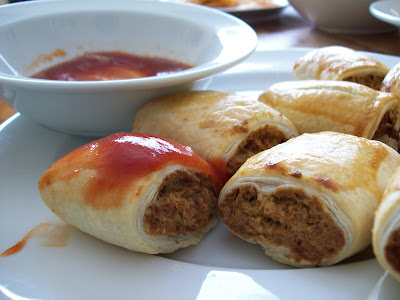In my defense, I had spent the better part of the afternoon drinking beer and eating BBQ shapes in the park for my sister's birthday, so it's not that I didn't want to cook up a storm, so much as I just didn't have the time.
That having been said, it was a very successful dinner. I love having friends who love to eat - not in a really foodie, always searching out the hottest new chef or fanciest, most obscure ingredient kind of way, but in the, let's sit down and consume lots of tastey food and delicious wine all together kind of way.
Unfortunately I didn't manage to get many photos of the dishes I prepared, and the ones I did take weren't fantastic. But, in the interest of conscientious food blogging. Below is a shot of all the dishes served last night (except for dessert.) Clockwise from far left we have:
- roast beetroot, goats cheese, walnut and mixed leaf salad
- homemade humus (I haven't quite perfected that yet)
- zucchini and ricotta tart in a parmesan crust
- white bean, carrot and dill salad
- homemade roast eggplant and yogurt dip
- cheese
- cabbage, raddish apple and mustard seed coleslaw

The only non-salad item on the menu was a the savoury tart. Adapted from one of Heidi's recipe at 101 cookbooks - I'd made it once before with a wholemeal flour and olive oil crust but decided to get a little bit more decadent this time around and use another of Heidi's recipes for a parmesan crust. Sadly, even with the helped of a loaned food processor, the pastry dough recipe just didn't work for me. My dough never really came together properly and stayed kind of pebbley and sandy even when I was trying to squish it into the pie dish. Hmmm - so the recipe that I've given here is with a couple of my amendments to the pastry recipe and a couple of additions to the fillings.
Zucchini and Ricotta Tart
Adapted from 101 cookbooks
Pastry:
1/2 cup plain flour
1/2 cup wholemeal flour*
120g cold, unsalted butter chopped into 1cm cubes
120g good parmesan, finely grated
1/2tsp salt
2tbs ice cold water
1 egg yolk
Preheat the oven to 180c
Put the flours, salt, butter and parmesan in the bowl of a food processor and pulse a couple of times till it's just combined and some of the butter is still in pea sized pieces. Add the iced water 1 tablespoon at a time, and pulse a couple of times after each spoonful. Now add the egg yolk and again pulse until just combined.
The dough should come together when you pinch it between your fingers.
Pour the dough into a pie dish and quickly and firmly press it into the shape of the dish, pushing the dough up the sides of the dish as well.
Pop the dish in the fridge for 15 minutes. Pull it out, prick with a fork a couple of times, place a piece of silver foil over the pastry and weigh down gently with pie weights or dry beans. Pop it into the oven for 15 minutes. Take the pastry out of the oven, remove the foil and weights and continue baking for another 10 minutes or until the pastry is golden brown and smells delicious!
Allow to cool at least a little before filling.
*You can always use just plain flour for this recipe - the wholemeal flour just makes it a little bit more rustic. However, if you do use only plain flour I would omit the egg yolk from the recipe because it will probably make the dough too wet.
Filling:
2 medium zucchini - sliced into rounds as thinly as possible
2 cans chopped tomatoes
2 cloves garlic -sliced
2tbs olive oil
300g fresh ricotta
1tsp salt
1/2tsp red chili flakes
handful fresh basil
Either keep the oven hot from baking the pastry or preheat again to 180c
Place the chopped zucchini in a colander and sprinkle on a fair amount of salt. Leave the zucchini to sweat while you start the sauce.
In a small pot, heat up the oil, garlic and chili until it starts to get fragrant, but not allowing the garlic to burn.
Dump in the cans of tomato and simmer for 15 minutes. Salt to taste.
Pick up handfuls of the zucchini and squeeze them well to try and get rid of any excess moisture that's in them.
Take your cooked pastry crust and spread about half the ricotta on the bottom. Then spread about one third of the tomato sauce, followed by about half the zucchini and half the basil, roughly torn. Repeat this process and finish with the last 1/3 of tomato sauce on the top.
Pop it in the oven and let it cook for about 30mins.
Serve warm to friends or cold, directly from the fridge the next morning when you're faced with a sink full of dishes and need some courage!
For those of you who have perservered with this post all the way to the end of the recipe - you will now be rewarded with another photo - nothing food related, just some lovely flowers that have been sitting on the ledge above my kitchen sink the last couple of days... they're really very pretty!



































